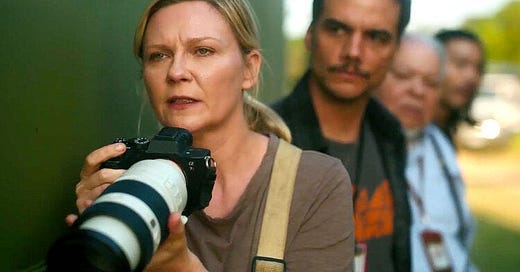Civil War
Alex Garland's urgent portrait of an American collapse harnesses its power from its sheer plausibility. It's also a paean to the enduring power of journalism to reveal ugly truths.
What makes “Civil War” so powerful is that it presents a scenario for America’s self-inflicted collapse that is simultaneously plausible, horrifying and unknowable.
Writer/director Alex Garland (“Ex Machina,” “Men”) does not present a political screed-slash-morality tale. It’s not about red states vs. blue states, though I’m certain some people will read an anti-MAGA message into it, because that’s where we are now.
The film, which follows a band of journalists as they attempt to make their way through a blasted hellscape to Washington D.C. to try to interview the beleaguered U.S. president, makes no mention of how the war started or exactly who’s on what side. The audience isn’t urged to cheer for any faction, and indeed is deliberately made to feel uncertain about which side is which.
One sequence is most telling. Legendary photojournalist Lee Miller (Kirsten Dunst), her reporter colleague Joel (Wagner Moura), elder New York Times statesman Sammy (Stephen McKinley Henderson) and novice photographer Jessie (Cailee Spaeny) wander into a bizarre Christmas display in the middle of the idyllic countryside. It’s so out of place, just so incredibly off, they don’t even need to see the body of the dead soldier in the roadway to know they’re in danger.
Soon pinned down by sniper fire from the nearby house, they encounter a pair of soldiers similarly situated, their own weapon scopes trained on the enemy’s position. The journalists do their thing and start asking questions: Who’s shooting at you? Do you know why? What side are they on?
One of the soldiers laconically replies that he doesn’t know any answers. Without taking his eye off his target, he says simply that there’s somebody in that house trying to kill them. So they’re trying to kill him first. That’s it. That’s all there is to know.
In addition to being a haunting proposition of the end of the United States, “Civil War” is also a paean to the enduring power of journalism to reveal truths — especially ugly ones.
Lee and Joel are longtime colleagues who have seen it all, documenting war zones all over the planet, only to find the worst one at home. America has become a series of factions, with the Western Forces, or WF, consisting primarily of an alliance of Texas and California, having seceded. There’s also a Florida Alliance causing trouble as far north as the Carolinas, and talk of Moaists holding Portland.
The president (Nick Offerman) offers televised assurances that America has the WF on the verge of total defeat. But he’s ensconced in a virtual bubble in D.C., having given no press interviews for the last 14 months. Sammy, representing the last vestiges of the Fourth Estate’s authority — and a former mentor of Lee’s — warns that journalists are being shot on sight there.
Nonetheless, Lee and Joel resolve to travel there via back roads and interview the president. They’ve got hard questions to ask, like why he unleashed the country’s full military force on civilians in the upstart states. Sammy convinces them to let him tag along, despite being old and not able to move very well. Jessie, who considers Lee a personal heroine, worms her way into their Ford Excursion.
Their journey takes the shape of a series of vignettes that open their eyes and sink their hearts. Some cities are just smoking craters. Refugees gather in parking lots elsewhere, incongruously happy and safe. There are pockets of small towns that seem completely untouched by the war… if you ignore the snipers looking down from the rooftops.
This war is not an organized rebellion but a chaotic splintering of America into me-first regional gangs and militias. Lee tries to purchase gas from some gunmen guarding the station and is told $300 won’t even buy half a sandwich. They’re happy to show off what happens to looters, though.
Wherever they go, three things seem always plentiful: bullets, booze and dope.
Joel is a strange dude. He seems to actually enjoy getting caught in firefights and other dangerous situations. He lives for the thrill. Though an encounter with a maniacally calm soldier (Jesse Plemons) who asks them “what kind of Americans” they are makes even his zest for peril falter.
Dunst’s Lee is the real fulcrum of the story. Jaded and cynical, she can barely stand having Jessie around, but starts to show her the ropes if only to keep her alive. Photographers see the world through their cameras, the best almost incapable of putting them down when everything around them goes to shit.
She advises the kid to just shoot everything, keep shooting, because you need a lot of snaps to get one good one. Thirty-to-one is a decent rate. Lee doesn’t make judgments, only photographs.
“We record so other people ask,” she says.
(One quibble: nowadays a visual journalist like her would be shooting at least 50/50 video and stills, probably wearing three running GoPros all the time.)
Their beleagured group will eventually make its way to the capital, resulting in an anguishing battle that’s as gripping as the opening sequence of “Saving Private Ryan,” a volatile mix of killing metal and breathing humanity. Bullets skip off the street pavement. It very much does not feel like a pretend flickershow.
“Civil War” works as an incredible piece of entertainment, if you can use that term for a depiction of America’s dissolution. Mostly, though, it’s a warning: keep doing what we’re doing, keep behaving the way we do towards those who are different from us, keep talking at people rather than to them, and this is where it leads.
This is a deeply sad and disturbing film. And, ferociously urgent.





